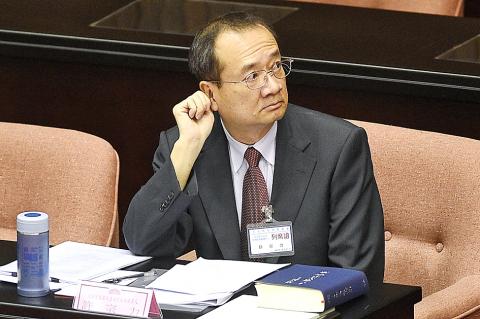Cross-strait relations are “special state-to-state relations” akin to the relations between West and East Germany, former grand justice Hsu Tzong-li (許宗力) yesterday told lawmakers during a review of his nomination to be head of the Judicial Yuan.
Hsu’s comment was in response to Chinese Nationalist Party (KMT) Legislator Alicia Wang’s (王育敏) question on whether his opinions on cross-strait relations were similar to those of former president Lee Teng-hui (李登輝), citing Hsu’s 1996 article, “How Laws Influenced the Changes in Cross-Strait Relations and the Latest Developments” (兩岸關係法律定為百年來的演變與最新發展) in the The Taiwan Law Review (月旦法學雜誌).
Lee’s “special state-to-state” model of cross-strait relations, announced on July 8, 1999, was aimed at countering China’s description of Taiwan as a “renegade province.”

Photo: Chen Chih-chu, Taipei Times
“Taiwan is a distinct sovereign independent nation separate from the People’s Republic of China [PRC] in Mainland China; its name is the Republic of China [ROC],” Hsu wrote in his article, adding: “The ROC is factually and legally independent from all other nations in the world, including the PRC.”
Hsu said he has always claimed “special state-to-state relations” and never used the phrase “two-state theory.”
When asked how his opinion differed from former president Ma Ying-jeou’s (馬英九) “one China, with different interpretations” framework, Hsu said that Ma’s cross-strait model claimed sovereignty over China and outer Mongolia, or the Republic of Mongolia, but that his model did not.
Ma’s preferred model is also known as the so-called “1992 consensus,” a phrase that former Mainland Affairs Council chairman Su Chi (蘇起) admitted to making up in 2000, which refers to a tacit understanding between the KMT and Beijing that both sides acknowledge there is “one China,” with each side having its own interpretation of what “China” means.
“Member of the Legislative Yuan, as well as the president, are elected by the 23 million people in Taiwan since 1991. We do not represent China. Therefore I think our sovereignty does not include mainland China,” Hsu said.
As for the distinction between the “Taiwan Area” and “Mainland Area” as stipulated in the Constitution, Hsu said that this was a political statement written into the Constitution and is not legally binding at the local government level, adding that were it legally binding, it would mean that Taiwanese would have to elect an “area administrator.”
New Power Party (NPP) Executive Director Huang Kuo-chang (黃國昌) asked Hsu about President Tsai Ing-wen’s (蔡英文) executive initiatives.
Huang asked if Tsai’s High-Level Policy Coordination Meeting initiative — a body composed of the premier, Democratic Progressive Party (DPP) secretary-general, key members of the DPP caucus and think tanks — crosses a “red line” regarding constitutional limits on presidential powers.
“I believe it must operate under the constitutional framework and I agree that regulations will cause many difficulties for Tsai. I hope the legislature considers constitutional amendments,” Hsu said.
Huang expressed the concern that the High-Level Policy Coordination Meeting sessions might lead to “controversial constitutional disputes” and asked Hsu if he thought the sessions should proceed as planned.
“I believe it warrants further consideration,” Hsu said.
Presidential Office spokesman Alex Huang (黃重諺) later issued a statement saying that “Hsu was responding to the issue of how the president’s constitutional role and powers should correspond with political responsibility and the spirit of democratic politics, and he believes that certain constitutional requirements require further review and consideration.”
The spokesman dismissed claims that the High-Level Policy Coordination Meeting was an unconstitutional expansion of presidential powers, saying that the sessions would enhance the Cabinet’s policymaking and “should cause no concern with regard to the constitutional boundaries of the president.”

FAST RELEASE: The council lauded the developer for completing model testing in only four days and releasing a commercial version for use by academia and industry The National Science and Technology Council (NSTC) yesterday released the latest artificial intelligence (AI) language model in traditional Chinese embedded with Taiwanese cultural values. The council launched the Trustworthy AI Dialogue Engine (TAIDE) program in April last year to develop and train traditional Chinese-language models based on LLaMA, the open-source AI language model released by Meta. The program aims to tackle the information bias that is often present in international large-scale language models and take Taiwanese culture and values into consideration, it said. Llama 3-TAIDE-LX-8B-Chat-Alpha1, released yesterday, is the latest large language model in traditional Chinese. It was trained based on Meta’s Llama-3-8B

STUMPED: KMT and TPP lawmakers approved a resolution to suspend the rate hike, which the government said was unavoidable in view of rising global energy costs The Ministry of Economic Affairs yesterday said it has a mandate to raise electricity prices as planned after the legislature passed a non-binding resolution along partisan lines to freeze rates. Chinese Nationalist Party (KMT) lawmakers proposed the resolution to suspend the price hike, which passed by a 59-50 vote. The Taiwan People’s Party (TPP) voted with the KMT. Legislative Speaker Han Kuo-yu (韓國瑜) of the KMT said the resolution is a mandate for the “immediate suspension of electricity price hikes” and for the Executive Yuan to review its energy policy and propose supplementary measures. A government-organized electricity price evaluation board in March

NO-LIMITS PARTNERSHIP: ‘The bottom line’ is that if the US were to have a conflict with China or Russia it would likely open up a second front with the other, a US senator said Beijing and Moscow could cooperate in a conflict over Taiwan, the top US intelligence chief told the US Senate this week. “We see China and Russia, for the first time, exercising together in relation to Taiwan and recognizing that this is a place where China definitely wants Russia to be working with them, and we see no reason why they wouldn’t,” US Director of National Intelligence Avril Haines told a US Senate Committee on Armed Services hearing on Thursday. US Senator Mike Rounds asked Haines about such a potential scenario. He also asked US Defense Intelligence Agency Director Lieutenant General Jeffrey Kruse

NOVEL METHODS: The PLA has adopted new approaches and recently conducted three combat readiness drills at night which included aircraft and ships, an official said Taiwan is monitoring China’s People’s Liberation Army (PLA) exercises for changes in their size or pattern as the nation prepares for president-elect William Lai’s (賴清德) inauguration on May 20, National Security Bureau (NSB) Director-General Tsai Ming-yen (蔡明彥) said yesterday. Tsai made the comment at a meeting of the Legislative Yuan’s Foreign Affairs and National Defense Committee, in response to Democratic Progressive Party (DPP) Legislator Wang Ting-yu’s (王定宇) questions. China continues to employ a carrot-and-stick approach, in which it applies pressure with “gray zone” tactics, while attempting to entice Taiwanese with perks, Tsai said. These actions aim to help Beijing look like it has